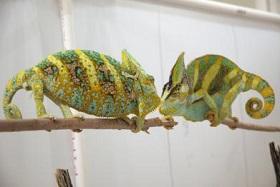Digital wellbeing should be a public health priority for the Arab region
21 October 2025
Published online 23 January 2014

Chameleons use their ability to change colour as a display of bravado to warn off contenders for mates and territory, researchers have found.
The colour-changing adaptation has long been recognised as a response to nervous stimulation, but it seems one species – native to parts of the Middle East – also change colour to send signals to each other. Zoologists from Arizona State University have deciphered the colourful language that males of one species use to communicate during confrontations.
Veiled chameleons (Chamaeleo calyptratus) are found especially in Saudi Arabia and Yemen. Males of the species are extremely aggressive, constantly challenging each another for mates and territory. In a typical fight, two males will stand sideways at a distance, hissing, rocking and curling their tails while rapidly changing colour to display bright yellows and oranges on their heads and flanks.
Russell Ligon, a behavioural ecologist from the university's School of Life Sciences, says: "By using bright color signals and drastically changing their physical appearance, the chameleons' bodies become almost like a billboard." The colour displays are usually enough to prevent the situation from escalating – if one turns and approaches its opponent, the other normally retreats.
To investigate how the colour changes are related to these behaviours, Ligon and his colleague, Kevin McGraw, set up one-on-one encounters among 10 male veiled chameleons and filmed them with high-definition cameras which took photographs every four seconds. They adjusted the images so the colours would appear as the chameleons would see them, according to what is known about how their eyes function. The scientists analyzed the images to observe how the chameleons' combat behaviours were linked to colour changes and brightness along 28 different areas on their bodies.
They found that certain aspects of the chameleon's colour-changes predicted their behaviours during the aggressive encounters.
Those who displayed the brightest stripes, visible during the initial side-on display, were more likely to escalate confrontations by approaching their opponent, and those with brighter head colours were more likely to win and make their opponents retreat. The speed of colour change was another important factor, with those whose head colours brightened fastest being more likely to win actual fights.
Ligon and others now suggest that the evolution of chameleons to change colours may not have been primarily for camouflage, but to convey social signals.
Chameleons move slowly and their fights progress in stages. Different parts of their body may convey various aspects of their competitive behaviours. If they do engage in physical combat, it usually ends within five to 15 seconds.
"I hope to follow this work up with a comparative, evolutionary approach looking at the evolution of colour change displays and behaviour across numerous species," says Ligon. "I am also very interested in how male chameleons use these kinds of colourful displays when courting females."
doi:10.1038/nmiddleeast.2014.24
Stay connected: